Name
MATH 154
PRACTICE FINAL
Please work out each of the given
problems. Credit will be based on
the steps that you show towards the final answer.
Do all of your work and show your solutions on your own sheet of paper.
Show your work.
Problem 1
Solve
![]()
We first subtract 2 from both sides
![]()
Now square both sides to get
x + 4 = (x - 2)2 = x2 - 4x + 4
x2 - 5x = 0 Subtracting x + 4 from both sides
x(x - 5) = 0 Factoring
x = 0 or x = 1 By the zero product theorem
Notice that when you plug in 0 you get 2 = -2 which is false. However x = 5 checks out. Hence the solution is
x = 5
Problem
2
A square floppy disk is of length 4.8 in across the diagonal. Determine the length of the side of the disk.
We first sketch the picture
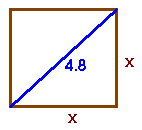
Now use the Pythagorean theorem to get
x2 + x2 = 4.82
2x2 = 23.04 Combining like terms
x2 = 11.52 Dividing by 2
x = 3.4 Taking the square root
The length of the side of the floppy is approximately 3.4 inches
Problem 3
Determine (f o g)(x) if f(x) = 2x - 1 and g(x) x2+ 2x
We have
f o g(x) = f(g(x))
= f(x2 + 2x) = 2(x2 + 2x) - 1
= 2x2 + 4x - 1
Problem 4
Graph the quadratic function. Label the intercepts and the vertex. Then put the parabola in standard form and explain in complete sentences how the parabola y = x2 has “shifted”.
y = x2 - 2x - 3
First find the y-intercept by plugging in 0 for x
(0,-3)
Next find the x-intercepts by plugging in 0 for y
0 = x2 - 2x - 3 = (x - 3)(x + 1)
x = 3 or x = -1
The x-intercepts are
(3,0) and (-1,0)
Now put it into standard form by completing the square
y = x2 - 2x - 3 = x2 - 2x + 1 - 1 - 3 adding and subtracting (-2/2)2 = 1
= (x - 1)2 - 4
Hence the vertex is at
(1,-4)
The standard parabola is shifted 1 to the right and 4 down. The graph is shown below
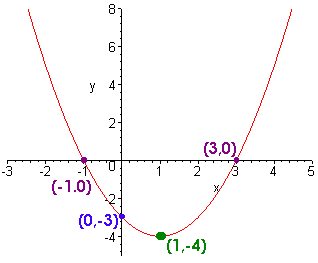
Problem 5
Sketch the graph of the following
A. 4x + 9y = 36
We see that this is a line since it has no square terms. We find the x-intercept by plugging in 0 for y to get
4(0) + 9y = 36
(9,0)
and the y-intercept by plugging in 0 for x to get
4x + 9(0) = 36
(0,4)
Now plot the points and connect the dots.
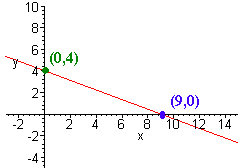
B.
y2 x2
-
=
1
25 4
This is a hyperbola since both x and y are squared and the signs are different. We have
a = 2 and b = 5 Square roots of 4 and 25
The vertices are on the y-axis since the positive belongs to the y-term. Now draw the fundamental rectangle, the diagonals, and then sketch the hyperbola.
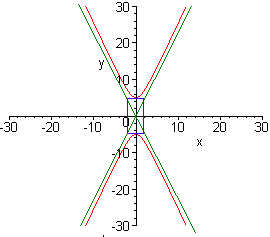
C. y = |x - 4|
This is an absolute value graph (shaped like a "V"). The vertex is shifted to the right by 4 so is at the point (4,0). The graph is pictured below
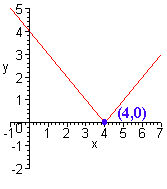
D. y = 3x + 2
This is an exponential with base greater than one. It is shifted 2 up. Plugging in 0 gives
30 + 2 = 1 + 2 = 3
Plugging in 1 gives
31 + 2 = 3 + 5 = 5
Now plot the points and connect with an exponential graph.
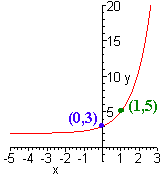
E. y = log2(-x)
This is the graph of a logarithm function with base greater then 2. The "-" sign reflects the graph about the y-axis. Hence we can only put in negative values for x. When x = -1, we get
y = log2(-(-1)) = log21 = 0
When x = -2, we get
y = log2(-(-2)) = log22 = 1
We now plot the points and connect with a logarithm curve.
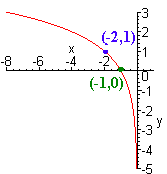
F. x2 + y2 - 4y = 12
This is a circle, since the coefficients are both the same number (1). We complete the square to get
x2 + y2 - 4y + 4 = 12 + 4 Adding (-2)2 = 4 to both sides
x2 + (y - 2)2 = 16
Hence the center of the circle is at
C = (0,2)
and the radius is
r = 4 The square root of 16
Now draw the circle
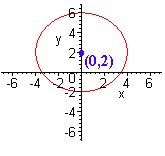
Problem
6
Determine whether the given function is 1-1. If it is find its inverse
A. f(x) = (x - 2)2
This is a parabola, so it does not pass the horizontal line test. In particular
f(1) = f(3) = 1
so it is not 1-1 hence there is not inverse function.
B. f(x) = 4 - 3x
x = 4 - 3y
x - 4 = 3y Subtracting 4 from both sides
x/3 - 4/3 = y Divide each term by 3
f -1(x) = x/3 - 4/3
Problem 7 Solve
A. 2x = 3x-1
We take log of both sides
log(2x) = log(3x-1)
x log 2 = (x - 1) log 3 Using the power rule
x log 2 = x log 3 - log 3 Multiplying through
x log 2 - x log 3 = -log3 Subtracting x log 3 from both sides
x(log 2 - log 3) = -log 3 Factoring out an x
-log 3
x =
= 2.7
Dividing by log 2 - log 3 and
log 2 -
log
3
using a calculator
B. log(37x - 1) = log(2x + 5) + 1
Subtract the logs to get
log(37x - 1) - log(2x + 5) = 1
37x - 1
log
= 1
Using the difference to quotient rule
2x + 5
37x - 1
= 101 = 10
Logs are exponents
2x + 5
37x - 1 = 10(2x + 5) = 20x + 50 Multiplying by the denominator
17x = 51 Subtracting 20x and adding 1 to both sides
x = 3 Dividing by 17
Problem 8 Expand the following logarithm. Simplify where possible. Assume all variables are such that all expressions are defined.

We use the quotient and product rules to get
![]()
Now cancel the log3 with the 3, and write the square root as an exponent to get
1 + log(x2 - 1)1/2 - log x - log(x2 + 1)5
Now use the power rule of logs
1 + 1/2 log(x2 - 1) - log x - 5log(x2 + 1)
Now factor to get
1 + 1/2 log[(x + 1)(x - 1)] - log x - 5log(x2 + 1)
Finally use the product to sum formula to get
1 + 1/2 log(x + 1) + 1/2 log(x - 1) - log x - 5log(x2 + 1)
Problem 9 Solve the system. then describe in words what is happening geometrically.
x2 + y2 = 25
2x + y = 5
Solving the second equation for y we get
y = 5 - 2x
Substituting into the first equation gives
x2 + (5 - 2x)2 = 25
x2 + 25 - 20x + 4x2 = 25 FOIL
5x2 - 20x + 25 = 25 Combining like terms
5x2 - 20x = 0 Subtracting 25 from both sides
5x(x - 4) = 0 Factoring
x = 0 or x = 4 Zero product property
Plugging in to the y = 5 - 2x gives
y = 5 - 2(0) or y = 5 - 2(4)
y = 5 or y = -3
Gives the points
(0,5) and (4,-3)
A quick check and we see that these two point satisfy both equations.
Problem
10
Write the following series in summation notation.
3
4
5
6
12
+
+
+ + ...
+
4
9
16
25
121
First we see that the numerator is arithmetic with
a1 = 3 and d = 1
We see that the denominator is the square of n + 1. Hence
3 + 1(n - 1)
an
=
(n + 1)2
The series begins at n = 1 and ends at n = 10 (since (10 + 1)2 = 121) We write
![]()
Problem 11
Find the indicated unknown for the arithmetic sequence.
S15 = 300, a15 = -8, a23 = ?
We use the formula
n(a1 + a15)
S15
=
2
Plugging in, we get
15(a1 - 8)
300 =
2
600 = 15(a1 - 8) = 15a1 - 120 Multiplying both sides by 2
720 = 15a1 Adding 450 to both sides
a1 = 48
Now we find d using a15
a15 = a1 + d(15 - 1)
-8 = 48 + 14d
14d = -56 Subtracting 48 from both sides
d = -4
Now use d and a1 to find a23
a23 = 48 - 4(23 - 1) = -40
Problem
12
Fifteen years ago 10,000 tons of trash were put into the landfall. Each year, because of growth, the trash used by the community is increased 10% over the previous year. How much total trash is in the landfill today? (use a geometric series)
We find the first few terms of the series
a1 = 10,000
a2 = 10,000 + (.1)(10,000) = (1.1)(10,000)
a3 = (1.1)(1.1)(10,000) = (1.12)(10,000)
We get the geometric series with
r = 1.1 a1 = 10,000 and n = 15
Now use the geometric series formula to get
a1(1 - rn)
Sn
=
1 - r
10,000(1 - 1.115)
Sn
=
= 317,725
1 - 1.1
There is 317,175 tons of trash in the landfill today
Problem 13
Answer the following true or false and explain your answer.
A. The only conic that is the graph of a function is the parabola y = ax2 + bx + c
True, ellipses, hyperbolas, and circles are not graphs of functions since they do not pass the vertical line test.
B.
![]()
False, the series diverges (equals infinity) since 2 > 1.
C.
log4(1 - x)
is undefined at x
= -3.
False
log4(1 - (-3)) = log4(4) = 1